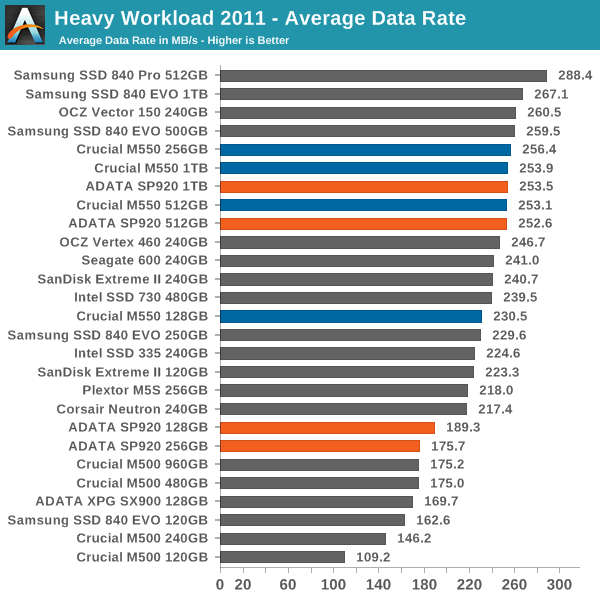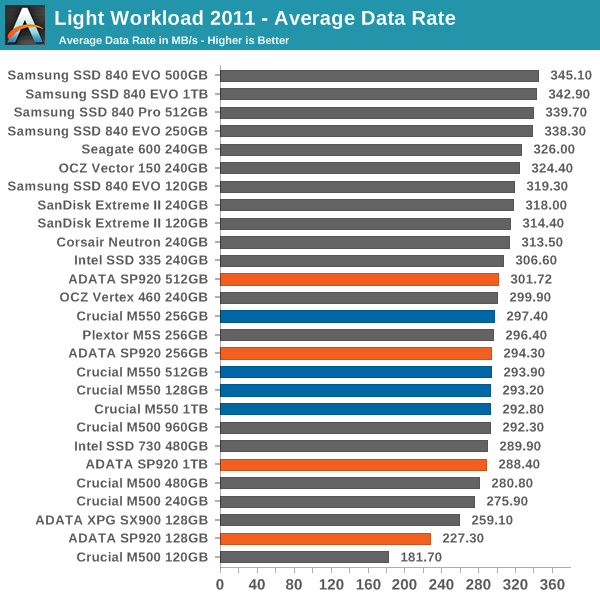ADATA SP920 (128GB, 256GB, 512GB & 1TB) Review
by Kristian Vättö on April 1, 2014 8:30 PM ESTAnandTech Storage Bench 2011
Back in 2011 (which seems like so long ago now!), we introduced our AnandTech Storage Bench, a suite of benchmarks that took traces of real OS/application usage and played them back in a repeatable manner. The MOASB, officially called AnandTech Storage Bench 2011 - Heavy Workload, mainly focuses on peak IO performance and basic garbage collection routines. There is a lot of downloading and application installing that happens during the course of this test. Our thinking was that it's during application installs, file copies, downloading and multitasking with all of this that you can really notice performance differences between drives. The full description of the Heavy test can be found here, while the Light workload details are here.


While the tests are now approaching three years old, the data they provide can still be meaningful. Despite the names, both the Heavy and Light workloads represent less strenuous loads than our 2013 suite, and the result is a tighter clustering of scores amoung the various drives. If you're a "typical" user and don't really stress your storage subsystem, most modern SSDs feel plenty fast, but there's still a pretty big drop off in responsiveness when we go below the 240/256GB mark. The SP920 again falls behind the M550 at both the 128GB and 256GB capacities here.










30 Comments
View All Comments
Samus - Wednesday, April 2, 2014 - link
Marvell controllers are just simpler than Sandforce (which is a good thing)Marvell has eDrive support in their newer controllers, simpler firmware, lower power usage, and no compression technology (making the implementation simple and performance consistent)
I prefer Marvell and Intel controllers over everyone else's but some newer controllers have looked promising (like OCZ's Barefoot)
Kristian Vättö - Thursday, April 3, 2014 - link
Marvell only provides the silicon - the firmware development is up to the manufacturer.hojnikb - Wednesday, April 2, 2014 - link
It's interesting to see that lower capacity versions perform better than m500, despite using the same die size flash. Is this because of the updated controller or more aggressive flash programming ?Samus - Wednesday, April 2, 2014 - link
They have the m550 controller but use the m500's NAND technology so the lower capacity drives are in between the m500 and m550 in performance.Kristian Vättö - Thursday, April 3, 2014 - link
Likely just better optimization at the firmware level.hojnikb - Thursday, April 3, 2014 - link
So in theory, they could update the m500 and boost it's, if they wanted ?hojnikb - Thursday, April 3, 2014 - link
*write speed, silly me :)(damn no edit option)
nick2crete - Wednesday, April 2, 2014 - link
Well ,i prefer to deal with Crucial than Adata even overseas where i am ..Hubb1e - Wednesday, April 2, 2014 - link
I just wanted to let the writer and editorial staff know that a good number of people skip right to the end of the article for the normal recap of the article's main points. This is especially true for SSD articles which IMO are getting to be a commodity and aren't all that interesting anymore. I felt that the final words didn't do a good job of recapping where this drive stands in the overall SSD segment, didn't give much in the way of a pro/cons for this drive, and refereed too much to a comparison with a drive that I don't know much about. This seems like a new writer so I wanted to let the staff know about my opinion on this so he can improve his next article for Anandtech.mcnaughty - Wednesday, April 2, 2014 - link
Totally agreed. Skip the waffle, we regular readers know all this already. Give us the numbers, and the interesting differences.